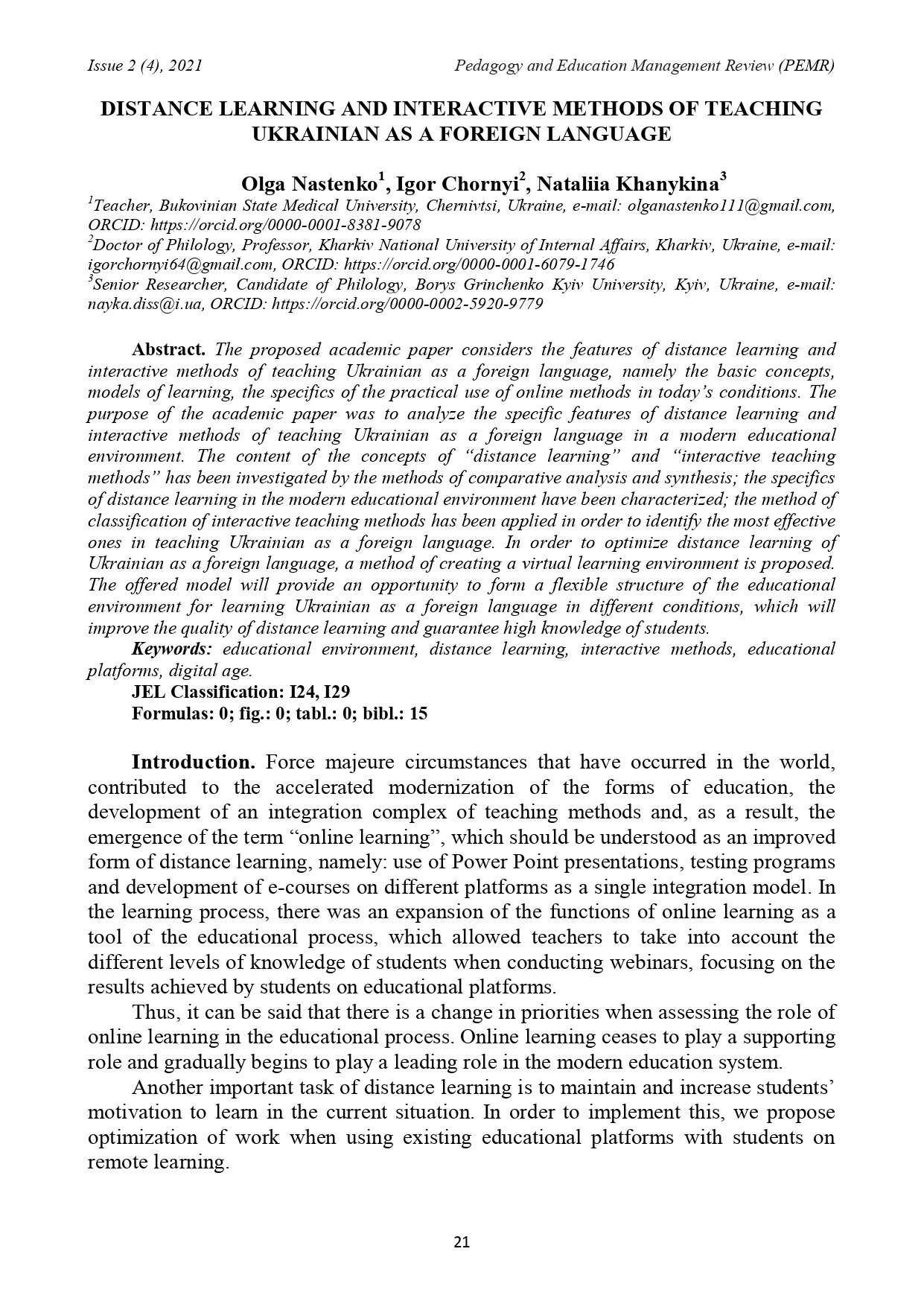DISTANCE LEARNING AND INTERACTIVE METHODS OF TEACHING UKRAINIAN AS A FOREIGN LANGUAGE
DOI:
https://doi.org/10.36690/2733-2039-2021-2-21Keywords:
educational environment, distance learning, interactive methods, educational platforms, digital ageAbstract
The proposed academic paper considers the features of distance learning and interactive methods of teaching Ukrainian as a foreign language, namely the basic concepts, models of learning, the specifics of the practical use of online methods in today’s conditions. The purpose of the academic paper was to analyze the specific features of distance learning and interactive methods of teaching Ukrainian as a foreign language in a modern educational environment. The content of the concepts of “distance learning” and “interactive teaching methods” has been investigated by the methods of comparative analysis and synthesis; the specifics of distance learning in the modern educational environment have been characterized; the method of classification of interactive teaching methods has been applied in order to identify the most effective ones in teaching Ukrainian as a foreign language. In order to optimize distance learning of Ukrainian as a foreign language, a method of creating a virtual learning environment is proposed. The offered model will provide an opportunity to form a flexible structure of the educational environment for learning Ukrainian as a foreign language in different conditions, which will improve the quality of distance learning and guarantee high knowledge of students.
Downloads
References
Evstigneev M.N. The structure of ICT competence of a foreign language teacher // Language and culture. 2011. № 1. P. 119-125.
Prigozhin I. Philosophy of instability // Problems of Philosophy. — 1991. — № 6. — P. 46-52.
Foucault M. Words and things. Archeology of the Humanities / Transl from French of V.P. Vizgin and N.S. Avtonomova. - SPb.: А-cad, 1994. — 408 p.
Luis Miguel Dos Santos The Discussion of Communicative Language Teaching Approach in Language Classrooms // Journal of Education and e-Learning Research. 2020. Vol. 7. № 2. Р. 104—109. ISSN(E) 2410-9991 / ISSN(P) 2518-0169. DOI: 10.20448/journal.509.2020.72.104.109
N.P.L. Nariyati, Sudirman, N.P.A. Pratiwi. EFL PRE-SERVICE TEACHER’S PERCEPTION TOWARD THE USE OF MOBILE ASSISTED LANGUAGE LEARNING IN TEACHING ENGLISH // International Journal of language Education. 2020. Vol. 4 № 1, March. Р. 38—47. DOI: 10.26858/ijole.v4i2.10052
Nadıran Tanyeli. The efficiency of online English language instruction on students reading skills. World Conference on Educational Sciences 2009. Procedia Social and Behavioral Sciences 1 (2009) 564—567 1877-0428 © 200 9 Els evier Ltd. doi:10.1016/j.sbspro.2009.01.102 Open access under CC BY-NC-ND license.
Muhammad Dafit Pitoyo, Sumardi, & Abdul Asib. Gamification-Based Assessment // The International Journal of language Education. 2020. Vol. 4. № 1, March. Р. 1—10. DOI: 10.26858/ijole.v4i2.8188
Reni Puspitasari Dwi Lestariyana and Handoyo Puji Widodo. Engaging young learners of English with digital stories: Learning to mean [Electronic resource] // INDONESIAN JOURNAL OF APPLIED LINGUISTICS.Vol. 2018 № 2, September. Р. 489—495. URL: http://ejournal.upi.edu/index.php/IJAL/article/view/13314.doi:10.17509/ijal.v8i2.13314
Sanchez R.A., Hueros A.D. Motivational factors that influence the acceptance of Moodle using TAM // Computersin Human. Behavior. 2010. Vol. 26(6). P. 1632—1640.
Schlosser, L.A.; Simonson, M.R.; Hudgins, T.L. Distance education: definitions and glossary of terms, Third edition. Charlotte, N.C.: IAP -Information Age Pub., 2010, P.1.
Machado M., Tao E. 2007. Blackboard vs. Moodle: Comparing User Experience of Learning Management Systems, in 37th ASEE/IEEE Frontiers in Education Conference, p. 7—12.
Suvorov R. Using Moodle in ESOL writing classes. TESL-EJ // The Electronic Journal for English as a Second language/ 2010. Vol. 14(2). P. 1—11.
Carolina Costaa, Helena Alvelosa, Leonor Teixeiraa. The use of Moodle e-learning platform: a study in a Portuguese University. CENTERIS 2012 Conference on ENTERprise Information Systems. 2212-0173 © 2012 Published by Elsevier Ltd. Selection and/or peer review under responsibility of CENTERIS/SCIKA — Association for Promotion. and Dissemination of Scientific Knowledge. doi: 10.1016/j.protcy.2012.09.037
Perraton, H. (1988). A theory for distance education. In D. Sewart, D. Keegan, & B. Holmberg (Eds.), Distance education: International perspectives. New York: Routledge, pp. 34–45.
Rumble, G. (1989). On defining distance education. The American Journal of Distance Education, #3(2), pp.8-21






